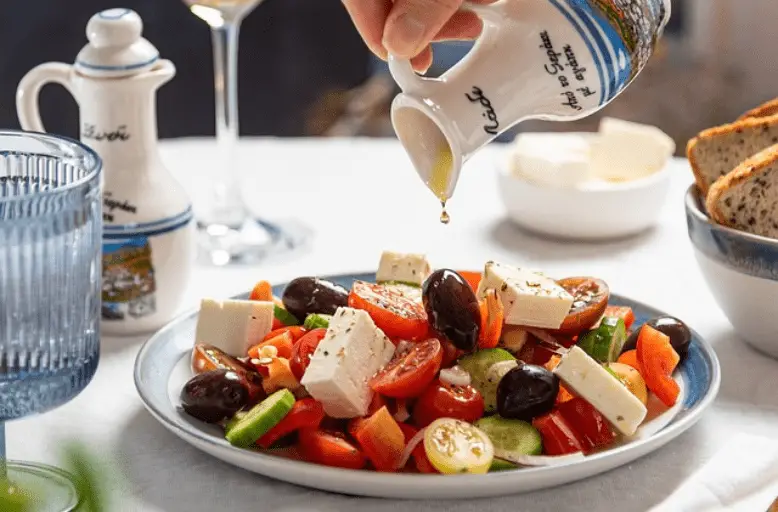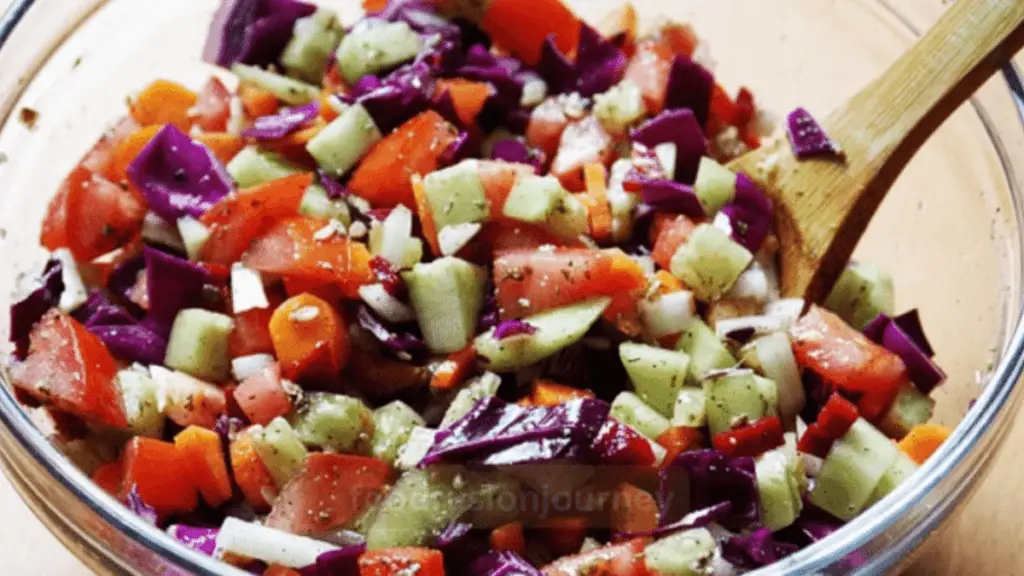Making a vegetable salad for weight loss is a nutritious and satisfying way to help control your calorie intek. Here’s a simple recipe for a healthy vegetable salad.
Gallery





Ingredients
Leafy Greens: Choose a base of leafy greens like spinach, kale, arugula, or mixed lettuce for vitamins and minerals.
Vegetables: Add a variety of colorful vegetables for flavor and nutrients. Its your choices to include tomatoes cucumbers bell peppers carrots and red onions.
Protein: Include a lean protein source like grilled chicken, tofu, or beans (such as chickpeas or black beans). Protein helps you feel full and satisfied.
Healthy Fats: Incorporate sources of healthy fats like avocado, nuts, or seeds. These can provide a feeling of fullness and essential nutrients.
Dressing: Opt for a light, homemade dressing using olive oil and vinegar or lemon juice. Avoid store-bought dressings that can be high in calories and unhealthy fats.
Seasoning: Use herbs, spices, or salt and pepper for flavor without adding extra calories.
Optional Additions: You can add other low-calorie ingredients like berries, apples, or a sprinkle of low-fat cheese for variety.
Instructions
1/ Wash and chop all your vegetables and protein source. You can also grill or roast the protein for extra flavor.
2/ Combine the leafy greens and chopped vegetables in a large salad bowl. Toss them together to create a colorful and visually appealing base.
3/ Add your chosen protein source, distributing it evenly throughout the salad.
4/ Slice or dice the avocado and sprinkle the healthy fats (nuts, seeds) on top of the salad.
5/ In a separate small bowl, mix the dressing. A simple vinaigrette can be made with three parts olive oil to one part vinegar or lemon juice, seasoned with herbs, spices, salt, and pepper. Drizzle it over the salad, starting with a small amount and adding more as needed.
6/ Toss the salad gently to coat the ingredients with the dressing.
7/ Taste and adjust the seasoning or dressing if necessary.
8/ Serve immediately and enjoy your delicious and nutritious vegetable salad.
Remember to watch your portion sizes, as even healthy salads can contribute to weight gain if you eat them in excess.
Tips and Tricks for Making Vegetable Salad for Weight Loss

Choose Leafy Greens: Start with a base of nutrient-rich leafy greens like spinach, kale, or mixed lettuce. They are low in calories and high in vitamins and minerals.
Colorful Vegetables: Incorporate a variety of colorful vegetables like tomatoes, cucumbers, bell peppers, and carrots. Different colors often indicate different nutrients, so a diverse mix is beneficial.
Lean Protein: Add a source of lean protein like grilled chicken, tofu, or beans. Protein helps keep you feeling full and satisfied, reducing the likelihood of overeating.
Healthy Fats: Include sources of healthy fats such as avocado, nuts, or seeds. These fats not only add flavor but also contribute to a feeling of fullness.
Portion Control: Pay attention to portion sizes. Even healthy salads can become high in calories if you consume large quantities. Use measuring cups or a food scale if needed.
Homemade Dressing: Create a simple, homemade dressing using olive oil and vinegar or lemon juice. Store-bought dressings are often high in calories and unhealthy fats.
Watch for Hidden Calories: Be cautious with high-calorie toppings like croutons, bacon bits, and excessive cheese. Use them sparingly if you include them at all.
Stay Hydrated: Drink water before and after your meal to help control your appetite and stay hydrated.
Avoid Sugary Dressings: Steer clear of sugary dressings, as they can add unnecessary calories and affect blood sugar levels.
Spice It Up: Use herbs, spices, or salt and pepper for added flavor instead of excessive dressing. This can cut down on added calories.
Meal Planning: Plan your salads in advance to avoid reaching for unhealthy, convenient options when you’re hungry.
Be mindful: Eat your salad slowly, savoring each bite. It takes time for your body to register fullness, so this can help you avoid overeating.
Variety: Keep your salads interesting by trying different combinations of vegetables, proteins, and dressings. This prevents salad fatigue.
Exercise: Combine your healthy eating with regular physical activity for more effective weight loss.
Record Your Progress: Consider keeping a food diary to track your salads and other meals. This can help you identify patterns and stay accountable.
Remember, weight loss is best achieved through a combination of a balanced diet and regular exercise. Vegetable salads can be a valuable part of your weight loss journey, providing essential nutrients while helping to control calorie intake.
Common Mistakes to Avoid During Making of Vegetable Salad for Weight Loss

Making a vegetable salad for weight loss is not a tuff task, i suggest some important and common mistakes to avoid that can undermine your healthy eating efforts. Here are some mistakes to steer clear of:
Using High-Calorie Dressings: One of the biggest mistakes is drowning your healthy salad in highcalorie dressings like creamy ranch or Caesar. Opt for light, homemade dressings or use them sparingly.
Adding Too Many High-Fat Ingredients: While healthy fats like avocados, nuts, and seeds are beneficial, using them excessively can add a significant number of calories. Use them in moderation.
Neglecting Portion Control: Even a healthy Vegetable Salad can contribute to weight gain if you overeat. Be mindful of portion sizes, and avoid loading your plate with oversized salads.
Skipping Protein: Protein is crucial for satiety. Not including a source of lean protein in your salad can leave you feeling hungry soon after eating, leading to overeating later.
Overdoing the Cheese: Cheese can be high in calories and saturated fats. Use it sparingly if you decide to include it in your salad.
Ignoring Sugar: Avoid sugary toppings like candied nuts, dried fruits, and sweet dressings. They can add unnecessary calories and lead to energy spikes and crashes.
Using Canned Vegetables: Fresh is best. Canned vegetables can contain added sodium and preservatives, which aren’t as healthy as fresh produce.
Not Enough Fiber: Fiber is important for fullness. Ensure your Vegetable Salad includes high-fiber ingredients like beans, lentils, or whole grains to help you feel satisfied.
Skipping Hydration: Drinking water is essential for a healthy diet and weight loss. Ensure you’re staying hydrated alongside your salad.
Eating Too Quickly: Eating too fast can prevent your body from recognizing that it’s full, leading to overeating. Take your time and savor your salad.
Neglecting Nutrient Variety: Don’t stick to the same salad ingredients all the time.
Not Prepping Ahead of Time: Failing to plan can lead to poor choices. Prepping salad ingredients in advance can save you time and help you make healthier choices when you’re hungry and in a hurry.
Ignoring Food Labels: When using store-bought items like salad dressings or canned ingredients, read the labels carefully to check for hidden sugars, unhealthy fats, and excessive sodium.
Not Balancing Macronutrients: A balanced salad should include carbohydrates, proteins, and fats. An imbalance can leave you feeling unsatisfied and lead to snacking on less healthy options later.
By avoiding these common mistakes and being mindful of your ingredients and portions, you can enjoy delicious and nutritious vegetable salads that support your weight loss goals.
Nutrition Facts

The nutrition facts of a vegetable salad for weight loss can vary depending on the specific ingredients used and portion sizes. However, here’s a general idea of the nutrition facts for a typical vegetable salad with a light dressing:
Note: These values are approximate and may vary based on the ingredients and portion sizes.
- Calories: Around 150-250 calories, primarily from vegetables, protein, and dressing.
- Protein: 10-15 grams (if you include lean protein sources like grilled chicken, tofu, or beans).
- Carbohydrates: 10-20 grams, mainly from vegetables and any added grains like quinoa or brown rice.
- Dietary Fiber: 4-8 grams, depending on the fiber content of the vegetables and any added beans or legumes.
- Fats: 7-15 grams, with a good portion coming from healthy fats like avocados, nuts, or olive oil in the dressing.
- Sugars: Minimal to no added sugars, mostly from natural sources in the vegetables.
- Sodium: Typically low, but it can vary based on ingredients and the amount of added salt in the dressing.
- Vitamins and Minerals: High in vitamins A, C, K, and various B vitamins, as well as minerals like potassium and magnesium, depending on the vegetables used.
It’s essential to remember that the specific nutrition facts can change depending on the ingredients you use, so it’s a good practice to calculate the nutrition facts based on the specific salad you prepare. Additionally, portion control and the types of ingredients used (e.g., the type of protein and dressing) can significantly impact the calorie and nutrient content of your vegetable salad.
FAQ – Vegetable Salad

What is a vegetable salad?
A vegetable salad is a dish made primarily of fresh vegetables, often accompanied by herbs, fruits, nuts, or other ingredients. It is typically dressed with a vinaigrette, dressing, or sauce.
How do I make a basic vegetable salad?
Start with a variety of fresh vegetables like lettuce, tomatoes, cucumbers, and bell peppers. Chop them into bite-sized pieces and toss together. Add your favorite dressing for flavor.
Can I customize my vegetable salad?
Absolutely! You can add a wide range of ingredients such as avocados, carrots, radishes, nuts, seeds, or cheese. Experiment with different combinations to suit your taste.
What dressings work well with vegetable salads?
Popular dressings include vinaigrettes, balsamic glaze, ranch, Caesar, or simple olive oil with lemon juice. Choose a dressing that complements the flavors of your chosen vegetables.
How do I keep my vegetable salad fresh for longer?
Store the salad in an airtight container in the refrigerator. Keep the dressing separate until ready to serve to prevent wilting. Consider adding delicate ingredients just before serving.
Can I make vegetable salad ahead of time?
Yes, you can prepare most of the components in advance and assemble the salad just before serving. However, avoid adding dressing until you’re ready to eat to prevent sogginess.
Is a vegetable salad a complete meal?
While a vegetable salad is nutritious, it may not always be a complete meal. Consider adding protein sources like grilled chicken, tofu, beans, or quinoa for a more balanced option.
What are some creative vegetable salad ideas?
Try a Mediterranean salad with olives and feta, a Thai-inspired salad with peanuts and lime dressing, or a roasted vegetable salad with a balsamic glaze.
Are vegetable salads suitable for special diets?
Yes, vegetable salads can be adapted for various diets, including vegetarian, vegan, gluten-free, or paleo. Customize the ingredients and dressings accordingly.
How can I make my vegetable salad more filling?
Add protein-rich ingredients like grilled chicken, chickpeas, quinoa, or cheese. Incorporating whole grains or legumes can also enhance the salad’s satiety.






